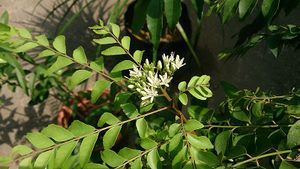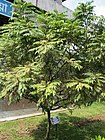Note: This is a project under development. The articles on this wiki are just being initiated and broadly incomplete. You can Help creating new pages.
Difference between revisions of "Murraya koenigii - Girinimba"
Chaithrika (talk | contribs) m (Chaithrika moved page Karibevu to Alakavhayah: renaming as per convention) |
(→List of Ayurvedic medicine in which the herb is used) |
||
| (23 intermediate revisions by 3 users not shown) | |||
| Line 1: | Line 1: | ||
[[File:Indian Curry Tree (Murraya koenigii) 3.jpg|thumb|right|''Karibevu'', ''Murraya koenigii'', ''Curry tree'']] | [[File:Indian Curry Tree (Murraya koenigii) 3.jpg|thumb|right|''Karibevu'', ''Murraya koenigii'', ''Curry tree'']] | ||
| + | '''Murraya koenigii''' belonging to Family Rutaceae. '''Murraya Koenigii''' is a highly values plant for its characteristic aroma and medicinal value. It is an important export commodity from India as it fetches good foreign revenue. | ||
| + | ==Uses== | ||
| + | {{Uses|Diarrhea}}, {{Uses|Gastric problems}}, {{Uses|Cancer}}, {{Uses|Cholesterol}}, {{Uses|Hairfall}}, {{Uses|Eyesight}}, {{Uses|Pathogen attack}}, {{Uses|Liver problems}}, {{Uses|Skin problems}}<ref name="Karnataka Medicinal Plants"/> | ||
| − | + | ==Parts Used== | |
| + | {{Parts Used|Leaves}}, {{Parts Used|Roots}}, {{Parts Used|Crust}}, {{Parts Used|Fruits}}.<ref name="Karnataka Medicinal Plants"/> | ||
| + | ==Chemical Composition== | ||
| + | Thirty-four compounds consisting of 97.4% of the oil were identified. The major constituents identified were α-pinene (51.7%), sabinene (10.5%), β-pinene (9.8%), β-caryophyllene (5.5%), limonene (5.4%), bornyl acetate (1.8%), terpinen-4-ol (1.3%), γ-terpinene (1.2%) and α-humulene (1.2%).<ref name="chemical composition"/> | ||
| + | ==Common names== | ||
| + | {{Common names|kn=Gandhabevu, Kari-bevinagida|ml=Kareapela|sa=Alakavhaya, Chhardighna|ta=Karivepillai|te=Karepaku, Karepeku|hi=Kari patta|en=Curry Leaf}}<ref name="Karnataka Medicinal Plants"/> | ||
| − | + | ==Properties== | |
| + | Reference: Dravya - Substance, Rasa - Taste, Guna - Qualities, Veerya - Potency, Vipaka - Post-digesion effect, Karma - Pharmacological activity, Prabhava - Therepeutics. | ||
| + | ===Dravya=== | ||
| − | + | ===Rasa=== | |
| − | + | Tikta (Bitter), Kashaya (Astringent) | |
| − | + | ===Guna=== | |
| − | + | Laghu (Light), Ruksha (Dry), Tikshna (Sharp) | |
| − | + | ===Veerya=== | |
| − | + | Ushna (Hot) | |
| − | + | ===Vipaka=== | |
| − | + | Katu (Pungent) | |
| − | + | ===Karma=== | |
| + | Kapha, Vata | ||
| + | ===Prabhava=== | ||
| + | ==Habit== | ||
| + | {{Habit|Herb}} | ||
| − | == | + | ==Identification== |
| + | ===Leaf=== | ||
| + | {{Leaf|Simple|Pinnate|The leaves are pinnate, with 11-21 leaflets, each leaflet 2-4 cm long and 1-2 cm broad}}<ref name="Leaf"/> | ||
| − | + | ===Flower=== | |
| − | + | {{Flower|Unisexual|2-4cm long|Yellow|5-20|The flowers are small white, and fragrant. Flowering from February to April}} | |
| − | |||
| + | ===Fruit=== | ||
| + | {{Fruit|Simple|7–10 mm|Clearly grooved lengthwise, Lowest hooked hairs aligned towards crown||Many|Fruiting from February to April}} | ||
| + | |||
| + | ===Other features=== | ||
| + | |||
| + | ==List of Ayurvedic medicine in which the herb is used== | ||
| + | [[Chundai Vittral Churnam]]<ref name="Karnataka Medicinal Plants"/> | ||
| + | |||
| + | ==Where to get the saplings== | ||
| + | ==Mode of Propagation== | ||
| + | {{Propagation|Seeds}}, {{Propagation|Cuttings}}. | ||
| + | |||
| + | ==How to plant/cultivate== | ||
| + | Periodical hoeing and in the first year intercrop like pulses can be grown<ref name="How to plant/cultivate"/> | ||
| + | |||
| + | ==Commonly seen growing in areas== | ||
| + | {{Commonly seen|Tall grasslands}}, {{Commonly seen|Meadows}}, {{Commonly seen|Borders of forests and fields}}. | ||
| + | |||
| + | ==Photo Gallery== | ||
| + | <gallery class="left" caption="" widths="140px" heights="140px"> | ||
| + | File:Murraya koenigii 01.JPG|Flowers | ||
| + | File:Murraya koenigii 02.JPG|Leaves | ||
| + | File:YosriPokokKari2.jpg|Leaves | ||
| + | File:Murraya koenigii (Curry leaf) tree in RDA, Bogra 02.jpg|Whole plant | ||
| + | File:Curry tree ripe fruits.jpg|Fruits | ||
| + | File:Curry Tree Fruit.jpg|Fruits | ||
| + | </gallery> | ||
| + | |||
| + | ==References== | ||
| + | |||
| + | <references> | ||
| + | <ref name="chemical composition">[https://www.sciencedirect.com/science/article/pii/S0962456203001437 Chemical constituents]</ref> | ||
| + | |||
| + | <ref name="Leaf">[http://www.flowersofindia.net/catalog/slides/Curry%20Leaf.html Plant description]</ref> | ||
| + | |||
| + | <ref name="How to plant/cultivate">[http://agritech.tnau.ac.in/horticulture/horti_vegetables_curry%20leaf.html Inter cultivation]</ref> | ||
| + | |||
| + | <ref name="Karnataka Medicinal Plants">”Karnataka Medicinal Plants Volume-3” by Dr.M. R. Gurudeva, Page No.244 and 247, Published by Divyachandra Prakashana, #6/7, Kaalika Soudha, Balepete cross, Bengaluru</ref> | ||
| + | </references> | ||
| + | |||
| + | ==External Links== | ||
| + | * [https://www.gardeningknowhow.com/edible/herbs/curry/growing-curry-leaf.htm Murraya koenigii on gardeningknowhow.com] | ||
| + | * [https://balconygardenweb.com/curry-leaves-plant-complete-growing-guide/ Murraya koenigii on balconygardenweb.com] | ||
[[Category:Herbs]] | [[Category:Herbs]] | ||
| + | [[Category:Ayurvedic herbs that don't have seed photos]] | ||
| + | [[Category:Rutaceae]] | ||
Latest revision as of 07:25, 3 September 2023
Murraya koenigii belonging to Family Rutaceae. Murraya Koenigii is a highly values plant for its characteristic aroma and medicinal value. It is an important export commodity from India as it fetches good foreign revenue.
Contents
- 1 Uses
- 2 Parts Used
- 3 Chemical Composition
- 4 Common names
- 5 Properties
- 6 Habit
- 7 Identification
- 8 List of Ayurvedic medicine in which the herb is used
- 9 Where to get the saplings
- 10 Mode of Propagation
- 11 How to plant/cultivate
- 12 Commonly seen growing in areas
- 13 Photo Gallery
- 14 References
- 15 External Links
Uses
Diarrhea, Gastric problems, Cancer, Cholesterol, Hairfall, Eyesight, Pathogen attack, Liver problems, Skin problems[1]
Parts Used
Leaves, Roots, Crust, Fruits.[1]
Chemical Composition
Thirty-four compounds consisting of 97.4% of the oil were identified. The major constituents identified were α-pinene (51.7%), sabinene (10.5%), β-pinene (9.8%), β-caryophyllene (5.5%), limonene (5.4%), bornyl acetate (1.8%), terpinen-4-ol (1.3%), γ-terpinene (1.2%) and α-humulene (1.2%).[2]
Common names
| Language | Common name |
|---|---|
| Kannada | Gandhabevu, Kari-bevinagida |
| Hindi | Kari patta |
| Malayalam | Kareapela |
| Tamil | Karivepillai |
| Telugu | Karepaku, Karepeku |
| Marathi | NA |
| Gujarathi | NA |
| Punjabi | NA |
| Kashmiri | NA |
| Sanskrit | Alakavhaya, Chhardighna |
| English | Curry Leaf |
Properties
Reference: Dravya - Substance, Rasa - Taste, Guna - Qualities, Veerya - Potency, Vipaka - Post-digesion effect, Karma - Pharmacological activity, Prabhava - Therepeutics.
Dravya
Rasa
Tikta (Bitter), Kashaya (Astringent)
Guna
Laghu (Light), Ruksha (Dry), Tikshna (Sharp)
Veerya
Ushna (Hot)
Vipaka
Katu (Pungent)
Karma
Kapha, Vata
Prabhava
Habit
Identification
Leaf
| Kind | Shape | Feature |
|---|---|---|
| Simple | Pinnate | The leaves are pinnate, with 11-21 leaflets, each leaflet 2-4 cm long and 1-2 cm broad |
Flower
| Type | Size | Color and composition | Stamen | More information |
|---|---|---|---|---|
| Unisexual | 2-4cm long | Yellow | 5-20 | The flowers are small white, and fragrant. Flowering from February to April |
Fruit
| Type | Size | Mass | Appearance | Seeds | More information |
|---|---|---|---|---|---|
| Simple | 7–10 mm | Clearly grooved lengthwise, Lowest hooked hairs aligned towards crown | Many | Fruiting from February to April |
Other features
List of Ayurvedic medicine in which the herb is used
Where to get the saplings
Mode of Propagation
How to plant/cultivate
Periodical hoeing and in the first year intercrop like pulses can be grown[4]
Commonly seen growing in areas
Tall grasslands, Meadows, Borders of forests and fields.
Photo Gallery
References
- ↑ 1.0 1.1 1.2 1.3 ”Karnataka Medicinal Plants Volume-3” by Dr.M. R. Gurudeva, Page No.244 and 247, Published by Divyachandra Prakashana, #6/7, Kaalika Soudha, Balepete cross, Bengaluru
- ↑ Chemical constituents
- ↑ Plant description
- ↑ Inter cultivation
External Links
- Ayurvedic Herbs known to be helpful to treat Diarrhea
- Ayurvedic Herbs known to be helpful to treat Gastric problems
- Ayurvedic Herbs known to be helpful to treat Cancer
- Ayurvedic Herbs known to be helpful to treat Cholesterol
- Ayurvedic Herbs known to be helpful to treat Hairfall
- Ayurvedic Herbs known to be helpful to treat Eyesight
- Ayurvedic Herbs known to be helpful to treat Pathogen attack
- Ayurvedic Herbs known to be helpful to treat Liver problems
- Ayurvedic Herbs known to be helpful to treat Skin problems
- Herbs with Leaves used in medicine
- Herbs with Roots used in medicine
- Herbs with Crust used in medicine
- Herbs with Fruits used in medicine
- Herbs with common name in Kannada
- Herbs with common name in Hindi
- Herbs with common name in Malayalam
- Herbs with common name in Tamil
- Herbs with common name in Telugu
- Herbs with common name in Sanskrit
- Herbs with common name in English
- Habit - Herb
- Index of Plants which can be propagated by Seeds
- Index of Plants which can be propagated by Cuttings
- Herbs that are commonly seen in the region of Tall grasslands
- Herbs that are commonly seen in the region of Meadows
- Herbs that are commonly seen in the region of Borders of forests and fields
- Herbs
- Ayurvedic herbs that don't have seed photos
- Rutaceae






